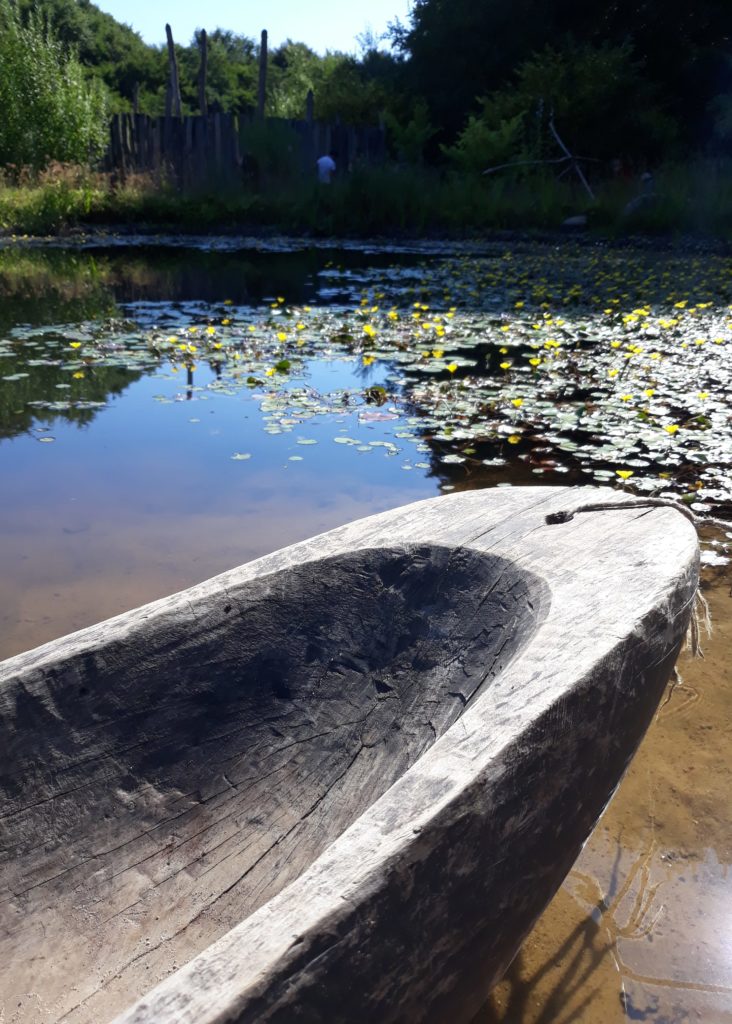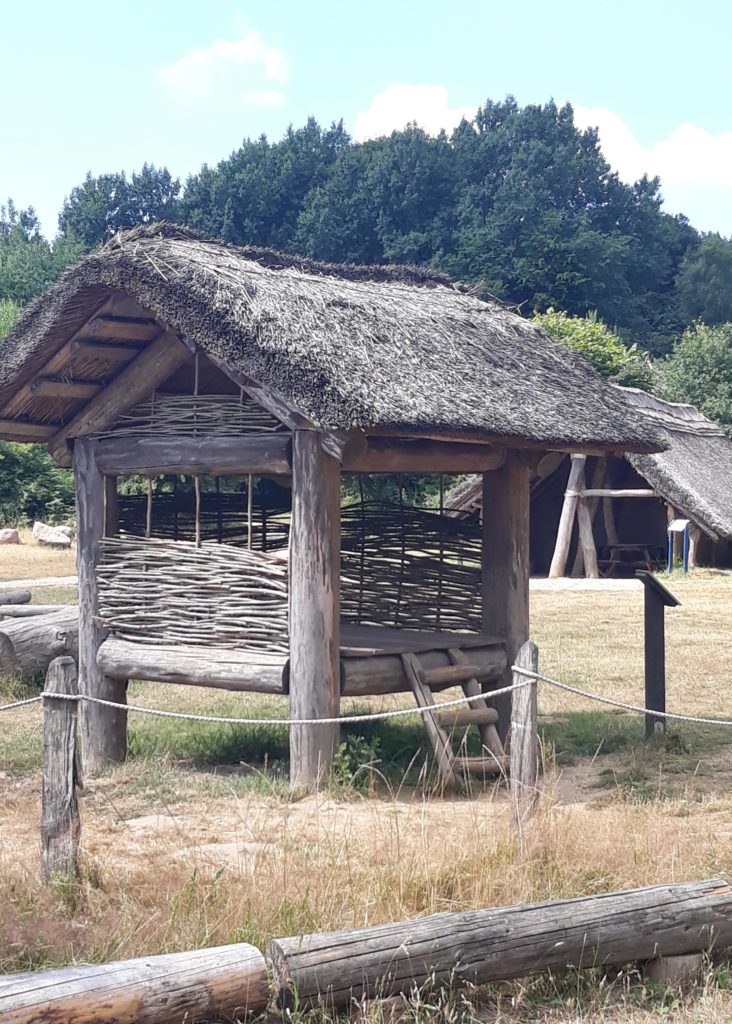Life in the Stone Age is a mystery. But we are lucky that there is a place where we can learn and experience this period of human history both in a scientific and in a fun way, which is quite remarkable!
On the outskirts of the small and sleepy town of Albersdorf, in northern Germany, close to the North Sea, is an open-air museum which aims to reconstruct life from the Stone Age period. This is the Steinzeit Park. It consists of true-to-scale outdoor reconstructions of huts, gardens, and open fire places. There is even a pond with water plants. Half of the museum is a grassy field (for play and work), the other half is a forest (for hunting and gathering). There are meandering alleys and wooden pathways that connect different locations, creating an exciting walk for the visitors. Once you enter you are allowed to stay as long as you’d like. You can even sleep there, what some people indeed do.
Despite the playfulness as described above, everything is based on sound archaeological sources and has strong scientific value! The open-air museum is actually a field for experimental archaeology. Every year, new elements are added making it worth revisiting and rediscovering. And these experiments don’t end with architecture or landscape design, they also stretch into the realm of intangible heritage. The members of a local association, vigorous in spirit and warm at heart, regularly dress in Stone Age outfits (wait, wait more on this topic will come later) and act out daily life of our prehistoric ancestors.








In this article we compiled three interviews that will give you a 101 lesson about the Stone Age. You will soon agree that this is a secondary world meant for your alter-ego to dwell there and be happy.

Dr. Rüdiger Kelm
Managing Director of AÖZA gGmbH
What is an open-air museum?
The European Association of Archaeological Open-Air Museums, defined what an archaeological open-air museum is:
An archaeological open-air museum is a non-profit permanent institution with outdoor true to scale architectural reconstructions primarily based on archaeological sources. It holds collections of intangible heritage resources and provides an interpretation of how people lived and acted in the past; this is accomplished according to sound scientific methods for the purpose of education, study and enjoyment of visitors.
EXARC 2008
“Open-Air Museum” means primarily outdoor based museum not indoor focused, like a “classic” museum with its collections and exhibitions, like our Museum of Archaeology and Ecology of the County of Dithmarschen in Albersdorf. Our both institutions (which are under the same management) interact educationally in the way that the visitors can see on the one hand the original findings and other scientific information in the museum, where the reconstructions in the park are based upon. The reconstructions and models in the Park give a living experience of the circumstances of life in prehistoric times.
What are the challenges of maintaining such a specific museum? And the privileges?
The challenge is above all the maintenance of the infrastructure of the open-air museum and especially the financing of it. But also the development and realisation of educational programmes which are both interesting for schools and tourists as while being scientifically correct.
It is a privilege to work with and develop such an interesting institution, in such a beautiful landscape. It is also a privilege for our staff, especially for our educators, to get such direct and emotional reactions to our programs and to our Stone Age Park as a whole.
What will the park look like in ten years?
In ten years we will have built the so-called “Stone Age House” which will be a new museum building in the entrance of the Stone Age Park. Then, we will welcome more visitors every year and become one of the European centres for the mediation of the Stone Age ( f. e. the European Route of Megalithic Culture, International Stone Age Fairs, Place for international scientific conferences etc.).
In our Park area we will develop more infrastructure for the palaeolithic (also neanderthal), mesolithic and neolithic surroundings. We will also install permanent museum educators in the different time periods. The whole Park will be better structured to offer a living experience about the oldest times of human history.

Volker Heesch
Head of the working group
Are the clothes made out of animal skins comfortable for daily use?
Stone age clothes look great! The visitors are very thrilled, when you wear stone age clothing, especially if you allow them to wear a piece of it. However, leather-clothes are much different from the cloths made out of cotton or wool fabric. They are heavier, but stronger. The wet leather needs much time to dry and during the drying process it becomes hard and you have to walk in it to keep it soft. But you don’t need to wash it, and you can wear it many years without getting worn.
How do children react to the Stone Age activities?
Most children are very surprised about the education in the Stone Age. They know that there was no school and the Stone Age children didn’t study reading or writing. But when we told them, that a ten-years-old child, could shoot by himself a rabbit, skin it, make a fire with a piece of wood, and cook the rabbit over the fire, and could build a small hut and live over the summer alone in the woods, the children are very astonished!
What was the most essential tool for the people in the Stone Age?
For sure it was the Flintstone blade, because every other tool is made by it. If you know how, it can be made very quickly, but unfortunately it is worn out as quickly. Thus, to do anything it was a slow process. For example, building a house takes about 4000 to 6000 hours (we just reconstructed one).

Erika Drews
Chair woman of AÖZA Förderverein e.V. association

What was your main motivation to join the community of engaged people of the Stone Age Park?
I like to do pottery, spinning and weaving and it was possible to practice these in the Stone Age Park.Now, for 4 years I have been the chairwoman of the Stone Age Friend’s Association, a local group of 730 members. Every year, we have a community of 40 to 50 participants living in the Hunter and Gatherer Age part of the park doing Experimental Archaeology with Werner Pfeifer, an enthusiastic specialist.
What can we apply from the Stone Age to a more sustainable lifestyle nowadays?
The Stone Age people must have had very good knowledge about the nature, for example about edible plants. Also, there was no need to transport fruits or vegetables around the world. They used nearly every part of an animal, not only the meat, but also the bones, furs, skins, horns. So there was very little waste.
Would you like to have lived in the Stone Age?
For me personally it would be impossible because I am a vegetarian. Despite this fact, I would like to live in a small community very close to nature and to sit in the evening together around a fire. I also like to work some days with children. While we are grinding the flour, transporting water, cracking hazelnuts with stones, gathering herbs and cutting them with flint stones, gathering wood, making fire with flint stone and marcasit, baking little “mini pizzas” they realise the work that had to be done, in contrast to go shopping in a supermarket.

Are you surprised and amazed by this, like we are?
The Stone Age Park is the right place for all of us, humans, to wonder if we could have lived like our ancestors did, 3000 years ago. If you are living a zero lifestyle, you will rediscover old environmentally friendly tricks. If you are a lover of museums and being outdoors, this is the perfect mixture of history and fresh air. If you are an explorer but also a tech geek, you can jump to a Stone Age version 2.0 and visit the Park’s website.
XXXXXXXXXXXXXXXXX